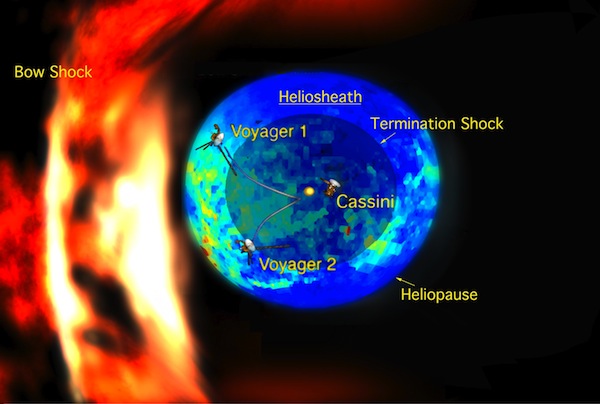UPDATED: Has the Voyager 1 Probe Finally Left the Solar System?
New data indicate the spacecraft, launched in 1977, has neared interstellar space, more than 11 billion miles away from the Sun
![]()

New data from the Voyager 1 probe, more than 11 billion miles away from the sun, indicate that it has entered interstellar space after 35 years of travel. Image via NASA/JPL
Update: Since the press release announcing Voyager 1′s exiting the solar system, NASA has clarified that the final indicator of this event—a change in the direction of the magnetic field surrounding the craft—has still not been observed. As was first observed in December 2012, Voyager 1 is in a new outermost region of the solar system called “the magnetic highway,” not true interstellar space. This post has been edited to reflect the clarification.
Since the dawn of the Space Age, our manned missions and unmanned probes have reached the Moon, asteroids and other planets. But only now do we have confirmation that a human-made object has reached a new milestone: The Voyager 1 space probe is at the furthermost edge of the solar system.
According to a paper recently accepted for publication by the journal Geophysical Research Letters, data transmitted by probe—which is now more than 11 billion miles away from the Sun—reveal that it has exited the heliosphere. The heliosphere (also called the heliosheath) is the region of space influenced by the solar wind and is commonly accepted as the outer border of the solar system. Thirty-five years, 6 months and 15 days after its launch, the spacecraft will soon enter the second phase of its mission—studying the interstellar medium that exists between our galaxy’s star systems.
Bill Webber of New Mexico State and F.B. McDonald of the University of Maryland (who has passed away since the paper was written) came to the conclusion after analyzing radiation data transmitted by Voyager 1 last August 25. The probe’s sensors detected that the levels of radiation from cosmic rays that had come from the Sun dropped to less than 1 percent of what they’d been previously, while radiation from galactic cosmic rays (which originate from beyond the solar system) doubled in intensity.
Although there is no exact boundary that defines the edge of the solar system, the point at which the Sun’s cosmic rays and galactic cosmic rays meet indicates the edge of the region dominated by our Sun’s solar wind, and thus the outside border of our star’s system. Webber says that the sudden change in radiation indicates Voyager 1 passed this point.
“Within just a few days, the heliospheric intensity of trapped radiation decreased, and the cosmic ray intensity went up as you would expect if it exited the heliosphere,” he said in a press release issued by the American Geophysical Union today. He also noted that it’s possible the probe hasn’t reached true interstellar space, but rather a separate, not-yet-understood region that lies in between our solar system and the interstellar medium.

This image from 2009 shows Voyager 1 at the edge of the heliosheath. But new data indicate Voyager 1 has passed the heliopause and entered the interstellar medium. Image via NASA/JPL
Since its launch in 1977, the spacecraft has conducted a grand tour of the solar system, passing by and photographing Jupiter and Saturn and providing us with some of the first-ever close-ups of the gas giants. Voyager 2, a twin probe, visited Jupiter, Saturn, Uranus and Neptune, and is still firmly within the solar system for now, 9.4 billion miles away from the Sun.
In 2005, Voyager 1 entered the heliosheath (the region in which the solar wind begins to slow down due to encountering the interstellar medium), and last October, researchers reported that it may have left the heliosphere altogether. Soon afterward, though, scientists cautioned that it may not have exited the heliosphere’s outer boundary, because a shift in the direction of the magnetic field had not yet been detected.
Despite the announcement alongside the new paper, this may still be the case—Voyager 1 may have finally exited the heliosphere, but not yet entered interstellar space per se. According to NASA, “A change in the direction of the magnetic field is the last critical indicator of reaching interstellar space and that change of direction has not yet been observed.” Thus, the probe is in an unexpected region in between the heliosphere and interstellar space, previously referred to as a magnetic highway.
Either way, though, it’s still in the starting stages of its journey, set to spend millennia—yes, millenia—traveling through the interstellar medium, though it will probably not be able to record or send back data after around 2025.
After an estimated 40,000 years, it will come relatively close (within a light year) to another star—and at that point, could serve as something of a time capsule. The Voyager 1 carries a Golden Record, designed to present a virtual snapshot of humankind to other life forms, contains everything from images of DNA and the Taj Mahal to recordings of whale sounds and Chuck Berry’s “Johnny B. Goode.”
As Timothy Ferris wrote in Smithsonian last May when he reflected on the 35th anniversary of the Voyager mission, “The Voyagers will wander forever among the stars, mute as ghost ships but with stories to tell…Whether they will ever be found, or by whom, is utterly unknown.”
/https://tf-cmsv2-smithsonianmag-media.s3.amazonaws.com/accounts/headshot/joseph-stromberg-240.jpg)
/https://tf-cmsv2-smithsonianmag-media.s3.amazonaws.com/accounts/headshot/joseph-stromberg-240.jpg)